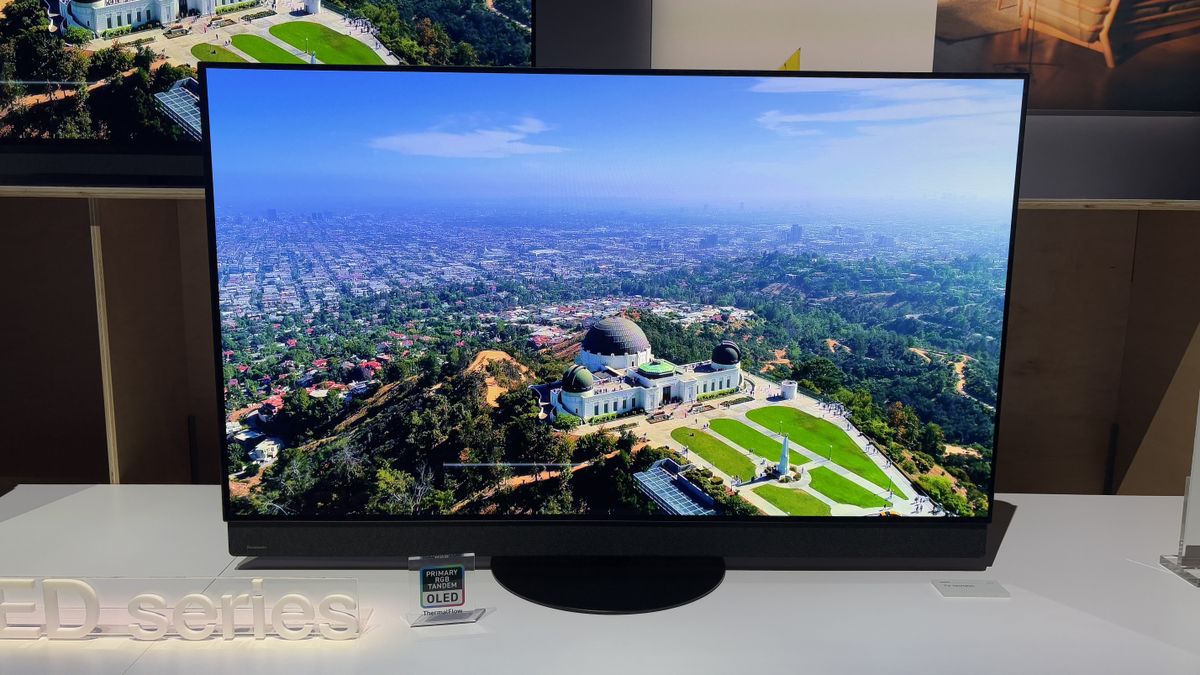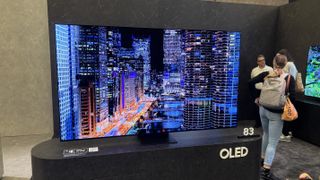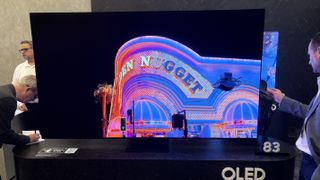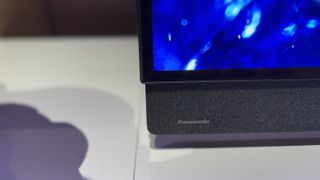Samsung S95F vs Panasonic Z95B: which 2025 flagship OLED TV should you buy?
Which one of these cutting-edge OLED flagships deserves pride of place in your home cinema setup?

The competition between premium TV manufacturers shows no signs of slowing down, with flagship models continuing to push the boundaries of what's possible from the best TVs. Both Samsung and Panasonic unveiled their latest high-end offerings at CES 2025 in the form of the Samsung S95F and Panasonic Z95B, with each promising significant advancements in picture quality, processing capabilities and overall performance. But which to choose? That’s where our below comparison comes in.
Note that before you scroll down, neither TV has made its way to our testing rooms yet, so we can't make definitive judgements about their performance. However, based on our hands-on experience with both models and their confirmed specifications, we can provide an initial comparison to help inform your potential purchase decision. We'll update this comparison once both models have been thoroughly reviewed in our dedicated testing facilities.
Samsung S95F vs Panasonic Z95B: price, sizes, and release date
Neither manufacturer has revealed official pricing yet, though we can make educated predictions based on their 2024 predecessors. The Samsung S95D launched at $2599 / £2499 for the 55-inch model, $3399 / £3399 for the 65-inch variant, and $4599 / £4599 for the 77-inch version. The Panasonic Z95A was priced at £3899 / $3200 for the 65-inch model.
The Samsung S95F will be available in 55-inch, 65-inch and 77-inch sizes – the same range as its predecessor. Panasonic matches this size range with the Z95B.
While exact release dates haven't been confirmed, the Panasonic Z95A launched in September 2024, while Samsung typically releases its flagship models earlier in the year.
Samsung S95F vs Panasonic Z95B: design and build

The Samsung S95F maintains the slim profile of its predecessor through its One Connect box system, which houses all connections and processing power. This connects to the display via a single cable, making it particularly suitable for wall-mounting scenarios. For those who prefer not to wall-mount, it also features a centrally mounted pedestal stand, ideal for positioning on narrower furniture.
Panasonic, meanwhile, has served up a complete chassis redesign for the Z95B to accommodate its new ThermalFlow cooling system. This cooling solution, inspired by F1 racing car aerodynamics, uses dedicated exhausts at the top and bottom of the device to maintain optimal operating temperatures.
The end result is a more uniform thickness throughout compared to previous models, which featured a boxed-out appearance to house speaker enclosures. The Z95B comes with a rotating pedestal stand as standard, and features a new grey acoustic fabric covering the front-facing speaker bar, with the Panasonic branding now shifted to the bottom left corner for a cleaner aesthetic.
Samsung S95F vs Panasonic Z95B: features and connectivity

The S95F incorporates Samsung's new NQ4 AI Gen 3 processor, bringing AI Upscaling Pro to its 4K flagship for the first time. This feature is designed to sharpen finer details and remove visual imperfections such as jagged lines and fuzzy textures. Samsung's Vision AI features extend beyond picture enhancement, to include practical functions such as AI art generation for wallpapers and actor information access via a dedicated remote button.
Panasonic equips the Z95B with its HCX Pro AI MK II processor, powering the 4K Remaster Engine for improved picture quality and noise reduction, which it says is particularly beneficial for streaming content.
The Z95B runs on Amazon's Fire TV platform and includes professional calibration capabilities through Calman and ISFccc support. It also features pre-calibrated modes developed with Hollywood colourist Stefan Sonnenfeld, aiming to deliver accurate picture quality out of the box. The inclusion of Dolby Vision IQ with Precision Detail, working in conjunction with an ambient light sensor, also allows the TV to adjust HDR performance based on room conditions.
Both TVs also offer comprehensive gaming credentials, though with notable differences. The Samsung S95F supports refresh rates up to 165Hz, while the Panasonic Z95B tops out at 144Hz. Both support VRR (with the Z95B specifically supporting AMD FreeSync) and ALLM for current-generation console gaming at 4K/120Hz. Samsung's provision of four HDMI 2.1 ports gives it an advantage over Panasonic's two — particularly relevant for users with multiple gaming devices. Both TVs support game streaming through their respective platforms, with Samsung offering specific partnerships with Xbox and Nvidia.
For HDR format support, Panasonic offers a more comprehensive package, supporting HDR10, HLG, HDR10+ and Dolby Vision. Samsung continues to exclude Dolby Vision, offering HDR10, HLG, and HDR10+ instead.
Samsung S95F vs Panasonic Z95B: picture quality

The S95F uses Samsung's latest QD-OLED technology, with the panel reportedly 30 per cent brighter than its predecessor while maintaining the same energy efficiency. Samsung claims peak brightness figures of around 2000 nits (up from 1650 nits on the S95D), and the S95F retains Samsung's glare-free technology for reducing reflections.
Panasonic takes a different approach with the Z95B, utilising LG Display's new four-stack OLED panel technology, which it calls the Primary RGB Tandem Panel. This new panel architecture represents a fundamental shift in OLED design, using completely separate red and green layers positioned between two blue layers, rather than combining red, green and yellow elements in a single layer. This multi-layer approach reportedly enables significant improvements in brightness while actually reducing energy consumption by around 20 per cent.
While Panasonic hasn't disclosed specific brightness figures for the Z95B, the underlying panel technology is apparently capable of peak brightness up to 4000 nits, and colour brightness up to 2100 nits – though real-world performance typically measures lower than theoretical maximums. We’ll have to wait and see. Panasonic's new ThermalFlow cooling system also aims to help maximise the panel's capabilities by maintaining optimal operating temperatures.
Both manufacturers are leveraging AI processing to enhance picture quality. Samsung's AI Upscaling Pro feature promises to sharpen finer details and remove visual imperfections such as jagged lines and fuzzy textures, while Panasonic's 4K Remaster Engine combines AI and mathematical models to improve picture quality, particularly with streaming content.
Samsung S95F vs Panasonic Z95B: sound

While most people are better off upgrading their built-in TV speakers with one of the best soundbars, we're still hoping to see some upgrades in the audio department from both models come review day.
Samsung introduces its new Eclipsa Audio technology on the S95F. Developed in partnership with Google, this open-source immersive audio format aims to provide creators with tools to adjust audio data, including location, intensity and spatial reflections of sounds to create an immersive three-dimensional experience. However, being a new format, we'll need to wait for our full review to assess how effectively it delivers on these promises and how widespread its adoption might become.
Panasonic has redesigned the Z95B's Technics-tuned 5.1.2 speaker system, integrating line array side-firing and height speakers directly into the TV's edges for a more expansive and dynamic sound stage. The subwoofer output has been increased from 20W to 30W, with the addition of a passive radiator for enhanced bass response. Panasonic claims this new configuration doubles the soundstage width compared to its predecessor, though we'll need to verify these claims in our testing rooms.
Samsung S95F vs Panasonic Z95B: early verdict
While both TVs show promising advances in OLED technology, we'll need to test them thoroughly before making definitive judgements. And we're very much looking forward to it. Each takes a distinct technical approach – Samsung with its enhanced QD-OLED technology and comprehensive gaming features, and Panasonic with its new four-stack OLED panel and professional-grade calibration options.
The choice between them may ultimately come down to your specific requirements, whether that's gaming connectivity, HDR format support, or specific picture processing capabilities. We'll update this comparison with a detailed performance analysis once both models have been fully tested in our review facilities, so stay tuned.
MORE:
LG G5 vs C5: what's new with these 2025 OLED TVs?
Hands on: Panasonic Z95B review
These are the most exciting TVs we saw at CES 2025
Get the What Hi-Fi? Newsletter
The latest hi-fi, home cinema and tech news, reviews, buying advice and deals, direct to your inbox.
